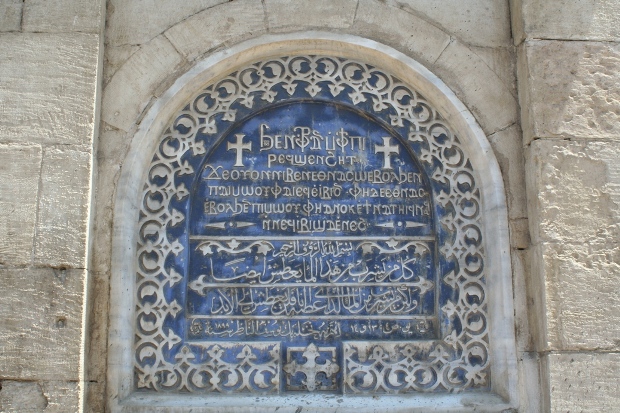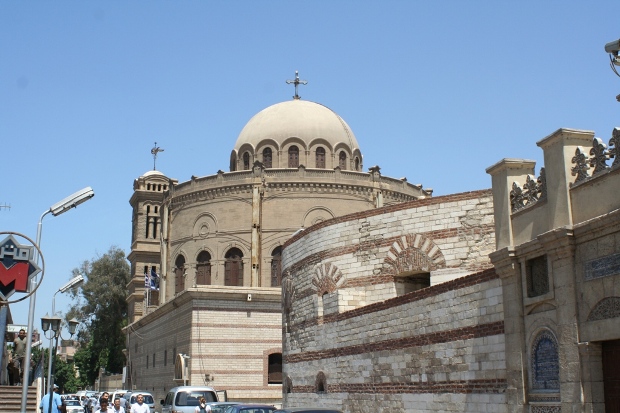|
Coptic Cairo’s star features:
Exploring Coptic Cairo can be easily done on foot. However,
categorizing the area’s sights by type is the best way to ensure
visitors enjoy a comprehensive discovery trip. The following is
a simple checklist of sights: Holy sites: include Churches,
tombs, convents and mosques, archeological sites: include
Fustat’s archeological remains, and last but not least Museums
and historic structures: Coptic Museum and the Nilometer.
The Hanging Church:
Is considered one of the most
beautiful churches in Egypt, dedicated to Virgin Mary. The
Church got its name “Hanging” or “ Al Muallaqa” in Arabic from
being built on top of the water gate of the old Roman fortress
of Babylon. Originally, the Church was constructed as early as
the 4th century, but was destroyed and re-built in the 11th
century. Allow yourself a long tour within the Church to soak up
the magnificence of its refined details evident in its ivory in
laid screens, and carved marble pulpit. The church is open daily
from 9 am to 4 pm, and public service takes place on both
Sundays and Fridays.

Coptic Museum:
Exhibiting some of the most
important pieces of Christian art, architectural sculpture and
writings in Christian history makes that Museum a must stop. The
Museum is divided into themed rooms each specified in exhibiting
different forms of Coptic art with evident Pharaonic and Islamic
influences. It is recommended to tour at a slow pace, and
visitors need not be worried about being accompanied by a tour
guide, as each room’s wall provides an overview and historical
background. Visitors can trace Christianity’s early development
in Egypt by closely watching symbols like the “ankh”, Horus like
falcons and impressive motifs. The museum is open daily from 9
am to 5 pm.

Church of Saint Barbra:
Named after a Christian
martyr who lived in the 3rd AD, and was killed for converting to
Christianity by her own father. The church is one of the largest
and finest in Egypt built in the 11th century. Make sure not to
miss the magnificent iconostasis dating back to around 1750.
Church of St Sergius:
the most famous Church in
Egypt, and it owes that reputation for once providing shelter to
the Holy Family in its cave during their “Flight to Egypt”. The
holy cave still exists and the church is the oldest structure in
the fortress built in 5th Century AD.
Church of St George:
Saint George was venerated
in the Middle East as Mar Girgis (with a metro station named
after him). It is believed that Mar Girgis has been a Roman
Legionary who defied a decree outlawing the practise of
Christianity, and hence was killed sometime in the 3rd century.
Ever since, the church has been dedicated to the Saint, whom
many Coptic Christians believe in his healing powers and visit
for blessings. The Church is open daily from 8am-12:45 pm and
2:30-3:15 pm.
Convent of St George:
Dating back to the 15th
Century, Saint George convent is still inhabited by nuns, where
the unusual ritual of chain wrapping is still practised. The
chains symbolize the persecution of Saint George, whose shrine
containing his famed icon can be visited in the high ceilinged
Great Hall. The convent is open daily from 8am-4pm.
Ben Ezra Synagogue:
Is Egypt’s oldest synagogue,
still standing after extensive restorations as a testament to
the significant presence of Jews in the country. The synagogue
was formerly a church, built in the 8th century, but was
destroyed three hundred years later, and its ruins were granted
to a 12th century rabbi of Jerusalem known as Abraham be Ezra.
The synagogue embraces thousands of Hebrew manuscripts that
chronically detail life in medieval Cairo. The synagogue is
daily open from 8 am-4pm.
Al Fustat:
Al Fustat translates to the tented
area in English, as it is here where the Muslims camped to
establish the first Islamic capital of Egypt overlooking the
River Nile to replace the Greco-Roman capital of Alexandria.
General Amr Ibn Al- Aas led the army and conquered the area in
641 AD, however, visitors will only be able to see archeological
remains of the capital, and its walls.
Mosque of Amr Ibn Al-Aas:
The mosque of Amr Ibn
Al-Aas was the first mosque to be built in Egypt by General Amr
Ibn Al-Aas after his army had succeeded in conquering the area.
Historical accounts detail that the mosque was built of simple
mud-brick, with an unpaved floor and palm trees serving as a
roof. However, as the number of Muslims increased the Mosque was
enlarged several times, losing much of its originality. Many
Greco-Roman pillars are evident in the mosque, which are said to
have been brought from Churches.
Nilometer:
The only surviving functional
structure of its kind in Egypt, built in 861 AD by the Abbassid
Caliph to measure the
River Nile’s floods. Make sure to also pay
a visit to the Manesterli Palace located on the eastern side of
the Nilometer.
Cemeteries:
During your tour to Coptic Cairo,
many cemeteries will bejewel your way. All of the cemeteries
around the compound belong to the Coptic, and Greek Catholic
communities. The structures are impressive, embracing
magnificent statues and elaborate mausoleums.
Continue Reading about Coptic Cairo
<< previous (1 -
2 -
3)
|
